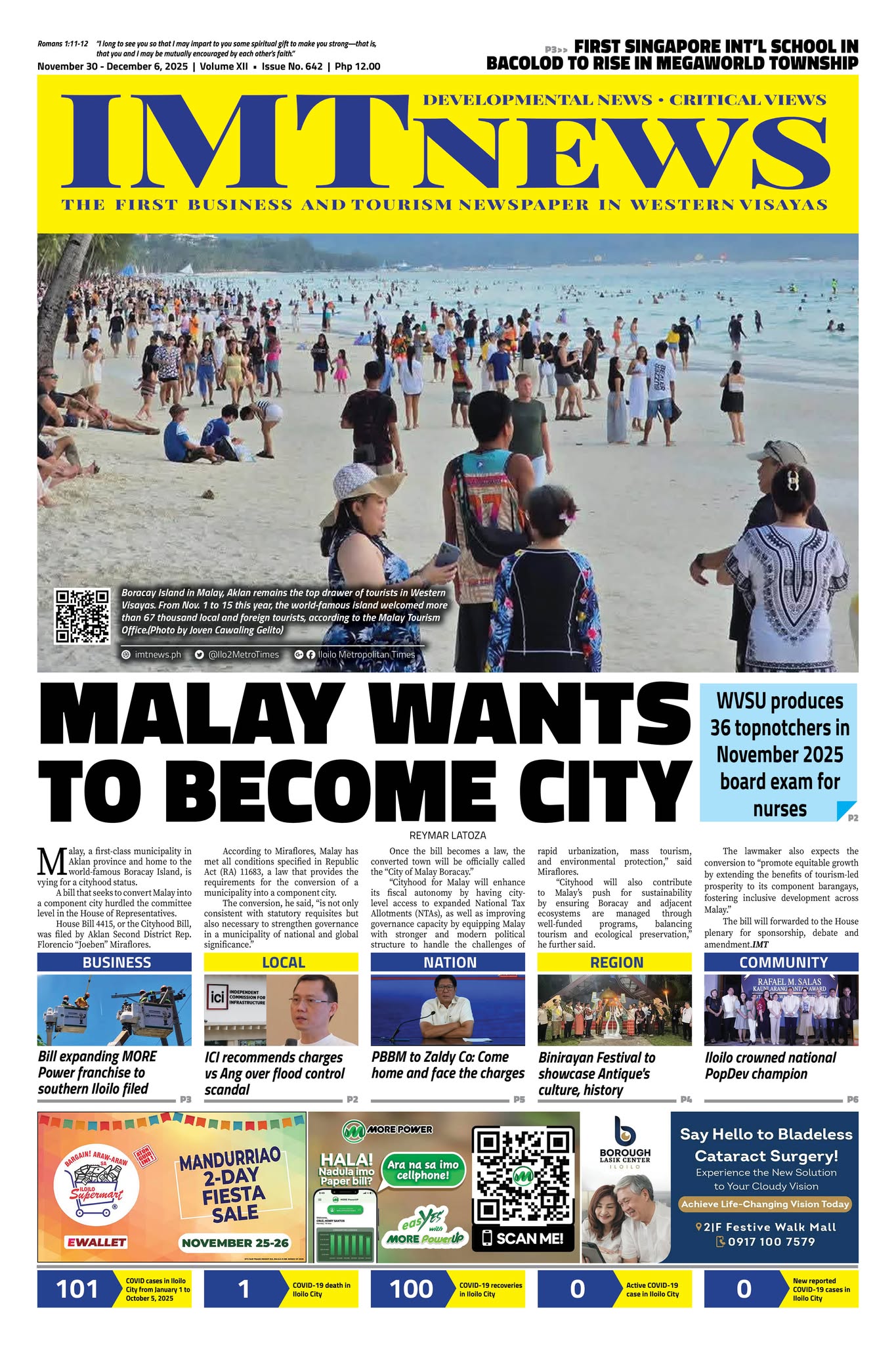If Iloilo Business Park, more popularly recognized by its commercial name Megaworld, had been guided by a sincere and sustained understanding of cultural responsibility, it might have chosen to reflect more critically on the honor extended to it by Executive Order No. 021. This executive issuance, which officially designates the private commercial district as Iloilo City’s “Center of Arts and Culture,” may appear at first glance to be a progressive and celebratory gesture. However, beneath this surface lies a web of more pressing and complex questions that require deliberate and uncomfortable confrontation. How do we define culture? Who is granted the authority to represent it? And most crucially, what processes are bypassed, ignored, or overwritten in the rush to assign symbolic power?
The conferring of such a significant title upon a real estate development project foregrounds image, branding, and commercial visibility over the integrity of cultural memory and the lived realities of the people who have long sustained it. It risks further marginalizing those individuals, collectives, and institutions that have carried Iloilo’s creative legacy with quiet endurance, limited resources, and a deep, hard-earned commitment to cultural life. It reduces the labor of generations to a decorative label. It implies that culture can be rebranded, professionally curated, and packaged into high-end infrastructure, detached from its social struggles and emptied of its historical contradictions.
Mayor Raisa Treñas publicly announced the designation on the afternoon of July 9 through a Facebook post. In doing so, the title was broadcast to the city not through an inclusive consultative forum, but through a unilateral digital proclamation. While many received the news with applause, particularly those aligned with development agendas and institutional narratives, many others especially those embedded in the arts sector, academic communities, and heritage circles were taken aback. For them, this act was not a moment of shared triumph. It was a moment of quiet grief. It was not the recognition of decades of cultural work, but its erasure in favor of convenience.
This moment demands that we ask, slowly and with care: What does it truly mean to be a center of arts and culture?
At its most essential, a cultural center is not a place of pristine facades or gated aesthetics. It is not a collection of galleries hosted in air-conditioned commercial buildings. Nor is it a schedule of tastefully executed events backed by corporate marketing. A true cultural center is rooted in history, animated by community, and sustained by a deep, often invisible infrastructure of relationships. It is a space where creation, reflection, dissent, and memory coalesce. It is not merely a site of celebration, but a site of struggle where difficult truths are held, where marginalized voices are amplified, and where tradition and experimentation are allowed to coexist in tension.
Most importantly, such a title is not something that can be granted through an executive order. Cultural legitimacy is not assigned from above; it is earned from below. It is not the outcome of a decree, but the result of generations of meaningful work: curating without funding, organizing without recognition, educating without institutional support, and remembering without monuments. Culture is not built overnight. It is the accumulation of stories, spaces, rituals, and resistances. It is the slow sediment of time, conflict, joy, and care.
When one carefully reads Executive Order No. 021, there is an overwhelming absence of any substantive rationale to support the bold claim it makes. There is no historical grounding, no genealogical tracing of cultural lineage, no public record of dialogue with the very communities who have shaped Iloilo’s creative ecosystem. The justification, instead, leans heavily on infrastructure, curated activity, and private sponsorship. These elements, while not without merit, are insufficient. They do not constitute cultural stewardship. At best, they are gestures toward visibility; at worst, they are mechanisms of appropriation.
Let us be precise: culture is not an accessory to real estate. It is not a backdrop for consumerism. It is not the aesthetic layer applied to an urban blueprint to make it more palatable for tourists or investors. True culture is inseparable from the life of the people. It resides in ancestral memory, in contested narratives, in the acts of reclaiming language, land, and identity. It is found not only in official exhibitions, but in street murals, in oral traditions, in poetry shared under dim lights, and in songs passed from grandmother to grandchild. It is expansive, unruly, and often inconvenient to the polished order that development seeks.
The site of Iloilo Business Park, once the location of the old Iloilo airport, has undergone significant transformation in the last decade. Yet it would be inaccurate, even intellectually careless, to claim that this transformation has produced a cultural nucleus. It has produced capital, infrastructure, and employment. But it has not produced, nor has it sustained, a cultural movement that can speak to the city’s deeper artistic and historical spirit. It is not a cradle of heritage, nor a sanctuary for experimentation. It is a commercial space, and its priorities are shaped accordingly.
To be a cultural center, it is not enough to build spaces. One must also build access, relevance, and critical engagement. Who enters these spaces, and who feels excluded from them? Are the arts used to interrogate and unsettle, or merely to beautify and brand? Are young artists being mentored? Are local languages being preserved? Are dangerous questions being asked? Are difficult histories being remembered?
In Megaworld’s case, the answer to many of these questions remains uncertain. The cultural activity it hosts tends to be curated in ways that align with corporate identity. Events are often accessible only to a narrow audience. Programming rarely challenges dominant narratives or opens space for political, indigenous, or anti-colonial expression. The culture that emerges in such spaces is frequently apolitical, commodified, and risk-averse.
Again, this is not inherently wrong. Commercial spaces may serve useful functions. They may support the arts in ways that are aesthetically pleasing and logistically convenient. But that alone does not justify the designation of “Center of Arts and Culture.” It is not merely a matter of contribution, it is a matter of depth, of authenticity, of historical and social embeddedness.
More importantly, we must ask: what kind of culture is being affirmed by this declaration? Whose stories are being told, and whose are being left out? What values are being normalized under the guise of art? Who is visible in this narrative of development, and who is made invisible?
True culture is not simply celebratory. It is critical. It asks difficult questions. It refuses easy answers. It disturbs the comfortable and comforts the disturbed. Can a space engineered primarily for consumerism, and framed by market logic, carry this responsibility?
If the answer is no, or even not yet, then it is not too late to reconsider.
Megaworld has contributed to the city’s recent modernization. That fact is not under dispute. But modernization is not synonymous with cultural stewardship. Economic vitality and cultural integrity are not interchangeable. One can build structures without building meaning. One can host events without building memory. One can fund the arts without truly standing in solidarity with artists.
To declare Megaworld as the cultural center of Iloilo is, intentionally or not, to sideline the work of countless individuals who have kept the city’s spirit alive without fanfare: community theater groups, heritage educators, poets, musicians, independent filmmakers, weavers, dancers, teachers, and memory-keepers. These cultural workers are often underpaid, underrecognized, and undervalued. But they are the true architects of culture. They are the quiet spine of Iloilo’s creative soul.
It is perhaps not too much to ask for a moment of humility. If those behind this designation feel that the responsibility it implies is heavier than anticipated, then they may consider returning the title, not in shame, but in honesty. Not as a step backward, but as a gesture of respect. The title may be held in trust for now. It may be something to work toward, not something to immediately claim. And in the meantime, Megaworld can continue to build partnerships, open its spaces, and deepen its engagement with the city’s living culture.
Let time, rather than titles, be the arbiter of truth. Let the people, not proclamations, define where culture lives.
Culture is not granted from above. It is cultivated from below.
And the city remembers.
Noel Galon de Leon is a writer and educator at University of the Philippines Visayas, where he teaches in both the Division of Professional Education and U.P. High School in Iloilo. He serves as an Executive Council Member of the National Commission for Culture and the Arts-National Committee on Literary Arts.







